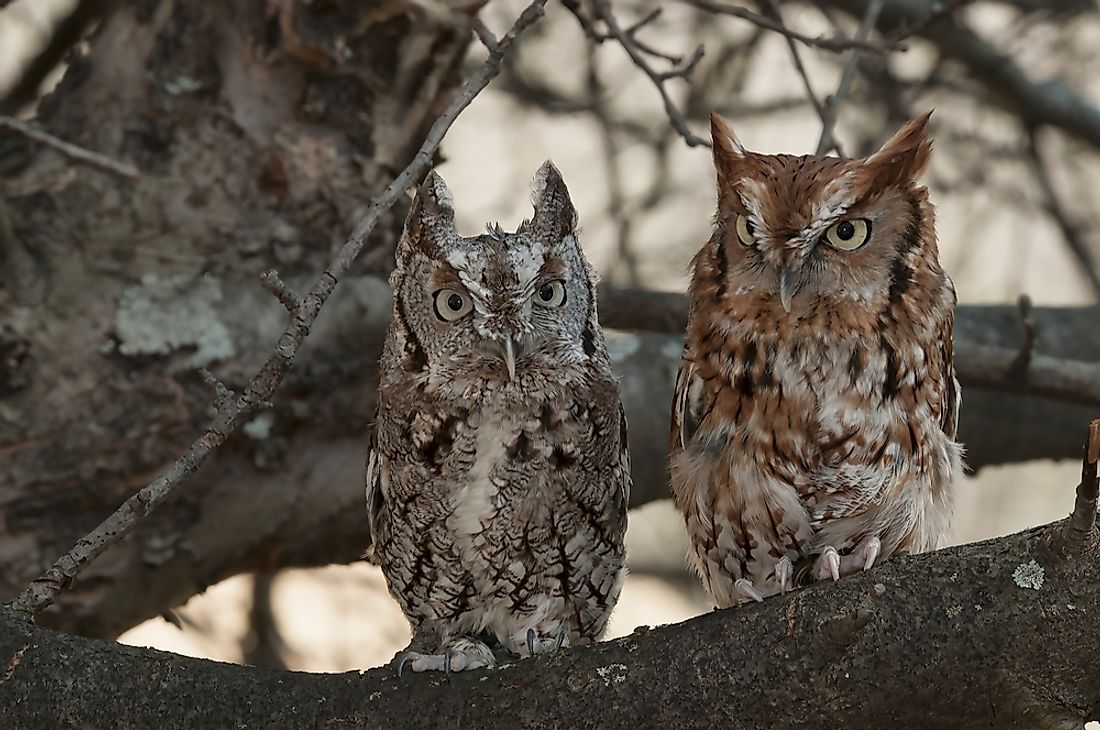Eastern Screech Owl Facts: Animals of North America

Screech owls are found particularly in the Americas where they are endemic. For the most of 20th century, this genus was categorized with the old world scops owls which belong to the genus Otus. However, it is now considered as a separate genus based on DNA sequencing, morphological, biogeographical, and behavioral data. Currently, there are 21 known species of screech owls belonging to the genus of Megascops one of which is the Eastern screech owl. There are five subspecies of the eastern screech owl which are found in eastern North America from Mexico to Canada.
Physical Characteristics
An adult eastern screech owl (Megascops asio) measures between 6.3 and 9.8 inches in length and approximately 4.3 to 8.6 oz. in weight, while the wingspan ranges approximately 18 to 24 inches. In appearance, they are either dark grey or rusty colored with intricate patterns on the plumage with streaks on the underparts. They are characterized by a round, large head, and outstanding ear tufts. They also have yellow eyes and the beak is yellowish as well, while its length is about 0.57 inches. The eastern screech owl also has strong and relatively large feet compared to the southern screech owl, and they have feathers covering to the toes.
Habitat and Range
The eastern screech owl is typically found in the deciduous forests, open mixed woodlands, wooded suburban areas, parks, woodlands near marshes, riparian woodlands, fields, and meadows. They are known to avoid locations commonly inhabited by larger owls, particularly the great horned owl (Bubo Virginianus). They can thrive in the face of urbanization and are considered more adaptable and successful than their counterparts like the barred owl (Strix varia) and barn owl (Tyto alba). The Eastern screech owls can nest and live along the borders of busy highways and even on top of the street light posts in the center of cities. Eastern screech owls are known to live anywhere from the sea level to as high as 49,000 feet above sea level in areas such as the Sierra Madre Oriental Mountains.
Feeding Habits
The eastern screech owl, like the majority of other raptors, is an opportunistic hunter. They are also versatile and ferocious hunters which led the early writers to nickname the owl as the “feathered wildcats.” In urban regions, eastern screech owls prey on introduced species to meet their dietary needs. House sparrows, lizards, house mice, and large insects like the cicadas form the diet of the owl. The bird hunts from the fall of darkness to early in the morning and mostly during the first hours when darkness falls. The bird takes advantage of its sharp vision and acute hearing to locate its prey, and they hunt by dropping down on their prey from perches. They can also hunt by scanning from the top of trees, and they can make short forays into open fields.
Conservation Status
The eastern screech owl is listed by the IUCN Red List as a least concern species due to their large population in the wild. The exact number of the population has been difficult to determine because it is a nocturnal bird. However, it is estimated that the population of the bird increased between 1966 and 2015, particularly in Canada but declined in the United States. According to the Partners in Flight, the estimate of the world population of the eastern screech owl is 900,000, and 95% of the population is in the US. The Eastern Screech owl is rated 20 out of 20 on the Continental Concern Score. In 2016, the species was not North America’s Bird Watchlist.











